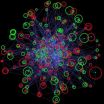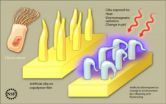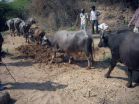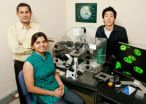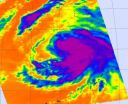(Press-News.org) Troy, N.Y. – Individuals within a networked system coordinate their activities by communicating to each other information such as their position, speed, or intention. At first glance, it seems that more of this communication will increase the harmony and efficiency of the network. However, scientists at Rensselaer Polytechnic Institute have found that this is only true if the communication and its subsequent action are immediate.
Using statistical physics and network science, the researchers were able to find something very fundamental about synchronization and coordination: if there are sustained delays in communication between just two or three parts of a system, performance of the entire system will eventually collapse. The findings apply to any network system where individuals interact with each other to collectively create a better outcome. This ranges from a flock of birds suddenly dodging to the right in one unified movement to avoid a predator to balancing load in large-scale computer networks to the spread of a rumor throughout an online social network.
The findings were published last month in Physical Review Letters in a paper titled "Network Synchronization in a Noisy Environment with Times Delays: Fundamental Limits and Trade-Offs." The findings were also highlighted among the Editors' Suggestions for that week.
Previous studies by the researchers have revealed that the minute interactions between neighboring individuals, referred to as nodes, are the foundation for overall network performance. The fast, accurate, and balanced movement of information between neighboring nodes is what prevents the birds from scattering and allows a story to accurately spread on the Web.
But, as is frequently the case in real-world scenarios, what happens when the information from your neighbor is not up to date? What occurs when there are delays in the transmission or processing of the information between neighbors? The researchers utilized stochastic differential equations, a type of mathematical equation used to model the time evolution of complex systems with random variables, to determine what happens when delays are input into the system.
"When there are no delays, the more you communicate with your neighbor, the better global performance becomes," said corresponding author for the paper and Associate Professor of Physics, Applied Physics, and Astronomy Gyorgy Korniss. "If there are delays, for a while performance will increase, but even if you work harder to better communicate with your neighbors, eventually performance will decrease until it reaches zero.
"Understanding the impact of delays can enable network operators to know when less communication effort can actually be more efficient for overall performance."
Their equations show that the larger the delay between nodes, the faster the overall coordination of the system will deteriorate. The work also reveals that, even with delays, there is a window of time where increasing communication will improve performance.
But, after a point, you also need to know when to "shut up," Korniss explained. After a certain period of poor communication, he said, no matter how fast or accurate you attempt to make your future communication, all communication is counterproductive.
"Our conclusion that coordination can sometimes be restored by decreasing node connectivity offers an important perspective on today's world with its abundance of connectivity in social and technological systems, raising the question of their stability," said study co-author Boleslaw Szymanski, Rensselaer's Claire & Roland Schmitt Distinguished Professor of Computer Science. Szymanski also serves as director of the Social Cognitive Network Academic Research Center (SCNARC) at Rensselaer.
The work, which is part of SCNARC, could be extended to real-life cases such a social or economic network. An example could be predicting the response of global markets to the trading of specific stocks, according to the researchers. The equations could someday help network operators to get the biggest pay off from each communication and develop an even stronger understanding of the power of the individual in mass communication.
INFORMATION:
First author for the paper was physics graduate student David Hunt. The research was funded by the Defense Threat Reduction Agency (DTRA) and by the Army Research Laboratory (ARL) through SCNARC, part of the Network Science Collaborative Technology Alliance (NS-CTA).
For more information on SCNARC, visit: http://scnarc.rpi.edu/.
To view videos that visualize the algorithms developed in the paper, visit: http://www.youtube.com/watch?v=KKNxulf7RNg and http://www.youtube.com/watch?v=9guRNGiNBAg&feature=related
Rensselaer researchers provide insight into the impacts of too much communication
Scientists looked at the failure of coordination in sophisticated networks from the Web to flocking birds
2010-09-24
ELSE PRESS RELEASES FROM THIS DATE:
Study finds high rate of c-sections after pelvic fractures
2010-09-24
In research led by a Saint Louis University surgeon, investigators found that women who give birth after suffering pelvic fractures receive C-sections at more than double normal rates despite the fact that vaginal delivery after such injuries is possible. In addition, women reported lingering, yet often treatable, symptoms following their pelvic fracture injuries, from urinary complications to post-traumatic stress disorder.
The study, published in Clinical Orthopaedics and Related Research, retrospectively reviewed the cases of 71 women who had suffered pelvic fractures, ...
Caltech researchers design a new nanomesh material
2010-09-24
PASADENA, Calif.—Computers, light bulbs, and even people generate heat—energy that ends up being wasted. With a thermoelectric device, which converts heat to electricity and vice versa, you can harness that otherwise wasted energy. Thermoelectric devices are touted for use in new and efficient refrigerators, and other cooling or heating machines. But present-day designs are not efficient enough for widespread commercial use or are made from rare materials that are expensive and harmful to the environment.
Researchers at the California Institute of Technology (Caltech) ...
University of Nevada, Reno, demonstrates successful sludge-to-power research
2010-09-24
RENO, Nev. – Like the little engine that could, the University of Nevada, Reno experiment to transform wastewater sludge to electrical power is chugging along, dwarfed by the million-gallon tanks, pipes and pumps at the Truckee Meadows Water Reclamation Facility where, ultimately, the plant's electrical power could be supplied on-site by the process University researchers are developing.
"We are very pleased with the results of the demonstration testing of our research," Chuck Coronella, principle investigator for the research project and an associate professor of chemical ...
Groundwater depletion rate accelerating worldwide
2010-09-24
WASHINGTON– In recent decades, the rate at which humans worldwide are pumping dry the vast underground stores of water that billions depend on has more than doubled, say scientists who have conducted an unusual, global assessment of groundwater use.
These fast-shrinking subterranean reservoirs are essential to daily life and agriculture in many regions, while also sustaining streams, wetlands, and ecosystems and resisting land subsidence and salt water intrusion into fresh water supplies. Today, people are drawing so much water from below that they are adding enough ...
Cilia revolution
2010-09-24
University of Southern Mississippi scientists recently imitated Mother Nature by developing, for the first time, a new, skinny-molecule-based material that resembles cilia, the tiny, hair-like structures through which organisms derive smell, vision, hearing and fluid flow.
While the new material isn't exactly like cilia, it responds to thermal, chemical, and electromagnetic stimulation, allowing researchers to control it and opening unlimited possibilities for future use.
This finding is published in today's edition of the journal Advanced Functional Materials. The ...
Taking a new look at old digs: Trampling animals may alter Stone Age sites
2010-09-24
Archaeologists who interpret Stone Age culture from discoveries of ancient tools and artifacts may need to reanalyze some of their conclusions.
That's the finding suggested by a new study that for the first time looked at the impact of water buffalo and goats trampling artifacts into mud.
In seeking to understand how much artifacts can be disturbed, the new study documented how animal trampling in a water-saturated area can result in an alarming amount of disturbance, says archaeologist Metin I. Eren, a graduate student at Southern Methodist University, Dallas, and ...
High pressure experiments reproduce mineral structures 1,800 miles deep
2010-09-24
University of California, Berkeley, and Yale University scientists have recreated the tremendous pressures and high temperatures deep in the Earth to resolve a long-standing puzzle: why some seismic waves travel faster than others through the boundary between the solid mantle and fluid outer core.
Below the earth's crust stretches an approximately 1,800-mile-thick mantle composed mostly of a mineral called magnesium silicate perovskite (MgSiO3). Below this depth, the pressures are so high that perovskite is compressed into a phase known as post-perovskite, which comprises ...
Cancer-associated long non-coding RNA regulates pre-mRNA splicing
2010-09-24
CHAMPAIGN, Ill. — Researchers report this month that MALAT1, a long non-coding RNA that is implicated in certain cancers, regulates pre-mRNA splicing – a critical step in the earliest stage of protein production. Their study appears in the journal Molecular Cell.
Nearly 5 percent of the human genome codes for proteins, and scientists are only beginning to understand the role of the rest of the "non-coding" genome. Among the least studied non-coding genes – which are transcribed from DNA to RNA but generally are not translated into proteins – are the long non-coding RNAs ...
GOES-13 sees tropical depression 15 form in the south-central Caribbean Sea
2010-09-24
The fifteenth tropical depression of the Atlantic Ocean season has formed in the south-central Caribbean Sea, and the GOES-13 satellite captured its swirling mass of clouds and showers in a visible image today. Watches and warnings are already up for Central America.
At 2 p.m. EDT today, Sept. 23, Tropical Depression 15 had maximum sustained winds near 35 mph. It was located about 485 miles east of Puerto Cabezas, Nicaragua, near 13.9 North and 76.2 West. It was moving west at 15 mph, and had a minimum central pressure of 1007 millibars.
The government of Nicaragua ...
NASA sees important cloud-top temperatures as Tropical Storm Malakas heads for Iwo To
2010-09-24
NASA's Aqua satellite has peered into the cloud tops of Tropical Storm Malakas and derived just how cold they really are, giving an indication to forecasters of the strength of the storm.
The Atmospheric Infrared Sounder instrument, known as AIRS has the ability to determine cloud top and sea surface temperatures from its position in space aboard NASA's Aqua satellite. Cloud top temperatures help forecasters know if a storm is powering up or powering down.
When cloud top temperatures get colder it means that they're getting higher into the atmosphere which means the ...
LAST 30 PRESS RELEASES:
Orthopedics can play critical role in identifying intimate partner violence
Worms as particle sweepers
Second spider-parasitic mite described in Brazil
January 2026 issues of APA journals feature new research on autism, pediatric anxiety, psychedelic therapy, suicide prevention and more
Private equity acquired more than 500 autism centers over the past decade, new study shows
New cervical cancer screening guidelines from the US Department of Health and Human Services
Estimated burden of COVID-19 illnesses, medical visits, hospitalizations, and deaths in the US from October 2022 to September 2024
Smartphone use during school hours by US youth
Food insecurity and adverse social conditions tied to increased risk of long COVID in children
Earliest, hottest galaxy cluster gas on record could change our cosmological models
Greenland’s Prudhoe Dome ice cap was completely gone only 7,000 years ago, first GreenDrill study finds
Scientific validity of blue zones longevity research confirmed
Injectable breast ‘implant’ offers alternative to traditional surgeries
Neuroscientists devise formulas to measure multilingualism
New prostate cancer trial seeks to reduce toxicity without sacrificing efficacy
Geometry shapes life
A CRISPR screen reveals many previously unrecognized genes required for brain development and a new neurodevelopmental disorder
Hot flush treatment has anti-breast cancer activity, study finds
Securing AI systems against growing cybersecurity threats
Longest observation of an active solar region
Why nail-biting, procrastination and other self-sabotaging behaviors are rooted in survival instincts
Regional variations in mechanical properties of porcine leptomeninges
Artificial empathy in therapy and healthcare: advancements in interpersonal interaction technologies
Why some brains switch gears more efficiently than others
UVA’s Jundong Li wins ICDM’S 2025 Tao Li Award for data mining, machine learning
UVA’s low-power, high-performance computer power player Mircea Stan earns National Academy of Inventors fellowship
Not playing by the rules: USU researcher explores filamentous algae dynamics in rivers
Do our body clocks influence our risk of dementia?
Anthropologists offer new evidence of bipedalism in long-debated fossil discovery
Safer receipt paper from wood
[Press-News.org] Rensselaer researchers provide insight into the impacts of too much communicationScientists looked at the failure of coordination in sophisticated networks from the Web to flocking birds
